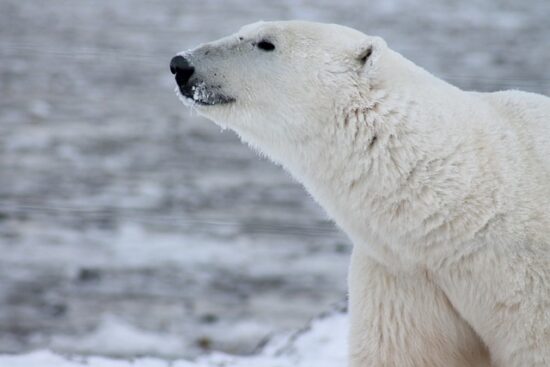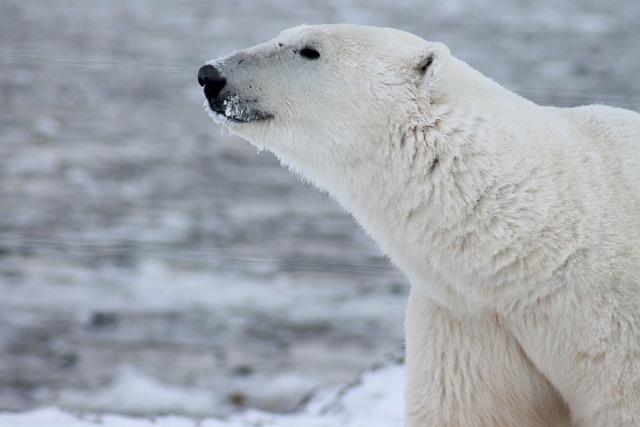Polar bear is one of the largest land carnivores in the world. Roaming on the hard sheet of Arctic ice with its 12-inch-wide paws, it has certainly evolved distinctive features for living on Arctic. Thanks to his short pointed claws and large furry feet which allow it to move easily on a cold surface. These arctic giants do not have any natural predator. Since they live on the most inhospitable earth’s environment they have to rely on their thick fur which serves as an insulating layer. Alongside its body and stocky legs, the ends of the paws are also covered with fur. As it turns out, the snowy white coat of polar bear offers an absolute camouflage against its prey. Now read out some of the most amazing polar bear facts for kids.
Polar Bear Facts For Kids
The scientific name of Polar Bear is Ursus maritimus
Subfamily of Polar Bears
Ursinae
1. Physical Characteristics of Polar Bear
Body-length
Polar bear is one of the largest carnivores on planet earth with the body-length measuring around 8 to 10 feet. Male polar bears can be as long as 8 – 9 feet (2.4 – 2.7 meters) with the shoulder height measures around 4 feet (1.2 meter). While they stand on their hind legs, it seems like a white giant is standing right in front of you. They reach 10 feet (3 meters) when standing.
Average Weight
Males have an average weight of 900 to 1,300 lb (400 to 590 kg) while females weigh around 450 to 600 lb (200 to 270 kg) on average.
Learn more: How Much Do Polar Bears Weigh?
Tail-length
Polar bears have 3 to 5 inches (7.5 to 12.5 cm) long tail.
Learn more: Do Polar Bears Have Tails
Largest Polar Bear
The largest polar bear ever recorded stood 12 feet (3.6 meters) and the weight measured around 2,000 lb (907 kg).
Color of the Fur…
They are predominantly white in color with the yellowish shade sometimes exhibits through their thick fur.
Elongated Neck
Unlike any other bear species, Polar bears have a straight neck. It appears as if there is something ahead which the bear is looking very closely.
Black Skin and black Nose
While polar bears have a greenish-white fur, their skin is entirely black. There is a dense layer of fat underneath the black skin with the thickness of 4.5 inches (11.5 cm). However, they are protected from intense cold because of fur and not due to their skin. Adults, when they run, go overheat after running. Like skin, its nose is also pure black.
Thick Curved Claws
The thick strong claws of polar bears offer considerable resistance which indeed facilitate it to walk slowly even on a slippery surface. Apart from walking, these claws are also used to hold the prey; besides, it offers a complete grip on the icy surface.
Learn More: Why Do Polar Bears have Large Feet?
 2. Behavior of Polar Bear
2. Behavior of Polar Bear
Solitary animals
Polar bears fancy living solitary lives and they are not territorial mammals. But they do occupy large home ranges. The social unit of these bears consists of females and cubs.
Males fight over females…
Male polar bears often get into confrontation (with each other) over a single female and the one who wins, takes the female.
Learn more: Polar Bear Life Cycle
Can Survive without food | Kill their Cubs…
Seldom do they find food in the extreme cold of Arctic; however, they are adapted to living several months without food. Polar bears can survive 4 to 5 months without food. But if they don’t find one after that much longer, it is highly likely that they would kill their cubs and eat them. When starved, polar bears can also kill their cubs especially male bears. Only one out of three cubs is known to reach adulthood.
Do not Attack Humans…
Main Article: Do Polar Bears attack Humans?
Unless provoked, polar bears do not attack humans. Bears never rely on humans to satisfy their hunger. Polar bears go after humans only when they feel threatened or when the mother bear is with her cubs. They are never afraid of humans which have brought both of them in perilous proximity. The mother bear will do anything to force her predator to move back.
Excellent Sense of Smell
Polar bears have an acute sense of smell and they can pick out the odor of their counterparts even at a distance of hundreds of kilometers.
Hunt without using Tools
Polar bears never use tools to kill their prey. Although they are often sighted to use one but scientists claim that this attitude may arise out of frustration when the attempt goes unsuccessful.
Learn more: What eats polar bear?
3. How Long Do Polar Bears Live
The average life span of polar bears is 25 to 30 years. The longest-lived polar bear ever recorded was 32 years. However, the captive polar bear (female) is known to survive 43 years max. Scientists aren’t sure as to what cause sudden death of these animals; global warming? Lack of food? Confrontation with humans? Fighting among themselves or something else.
 4. Where Do Polar Bears Live
4. Where Do Polar Bears Live
Polar Bear facts for kids
Distribution
Polar bears have circumpolar distribution with the range extending to the Arctic Ocean ice pack. They are widely distributed in northern Canada, Asia, and Europe in summer. However, in winter polar bears are found in the northern Bering Sea, Canada, and Newfoundland. Polar bears are not found in Antarctica though many were forced to leave their natural habitats in Arctic and they started migrating towards Antarctica. This led scientists to believe the real cause of their shorter life span.
Habitat
Polar bears love to reside in the hard ice fields and Arctic snow while the southern bears also join them. They are often referred to as marine mammals because they spend a large amount of time in water and ice pack.
5. What Do Polar Bears Eat | Polar Bears Diet
Polar bears primarily rely on fish and seals. These animals are not so difficult to hold on because polar bears are excellent swimmers. They can swim the longest once the prey is ahead. Additionally, bears have an acute sense of smell which enable it locate its prey within a thick ice sheet. Once the prey is located beneath the surface, they give a fatal blow (with their strong paws) to make a hole and drag the seal out. However, polar bears do not necessarily succeed and often their attempt goes in vain.
Learn more: What do Polar Bears Eat
Are they Really going Extinct?
While polar bears are likely to go extinct in the next 20 years or so, they are nevertheless still present in large numbers especially if you happen to visit the western shore of Hudson Bay. The Hudson Bay is home to thousands of polar bears each year where they meet in order to hunt seals. Not to underestimate their numbers, they are believed to be present two times of what they were 10 years ago.
This means that the recent attempts to conserve these species have really worked. The director of the wildlife, Drikus Gissing claims that, “Polar bears are one of the biggest conservation success stories in the world.” However, many biologists seem to have entirely different opinions with regard to these species and they don’t agree with Drikus. According to them, polar bears are dying of drowning and starving.
Apart from all the discussions on polar bear’s existence, one thing is for sure; they are not as threatened as they were few years back. The U.S. Geological Survey have figured out that if humans trim down the emissions of greenhouse gas in the next couple of decades, Arctic ice may not melt rapidly in summer and early autumn, thereby helping polar bears to survive.


Leave a Reply